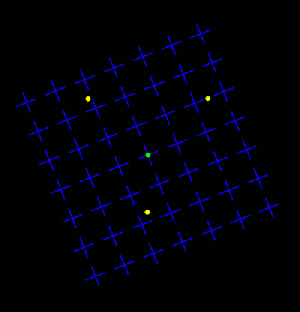Motion Induced Blindness
I received this from reader Albert Masetti as a demonstration on eye fixation.
Michael Bach, a Professor at the University of Freiburg has a full page of Optical Illusions and Visual Phenomena. The strength of this site is that he allows for controls for each of the illusions, so that you can check for yourself what is actually happening (as opposed to what you are seeing). Each illusion has a full explanation as to the effect and why it occurs. He’s kindly given permission for his experiments to be recreated, so you play with his Motion Induced Blindness example here:

You should see a rotating array of blue crosses and 3 yellow dots. Now fixate on the centre (watch the flashing red/green spot). Note that the yellow spots disappear once in a while: singly, in pairs or all three simultaneously, right?
In reality, the 3 yellow spots are continuously present, honest! This is captively called “motion induced blindness” or MIB.
A retired Marine aviator describes the phenomenon:
This is a great illustration of what we were taught about scanning outside the cockpit when I went through training.
We were told to scan the horizon for a short distance, stop momentarily, and repeat the process. I can remember being told why this was the most effective technique to locate other aircraft. It was emphasized repeatedly to not fix your gaze for more than a couple of seconds on any single object. The instructors, some of whom were veterans with years of experience, instructed us to continually “keep our eyes moving and our head on a swivel” because this was the best way to survive, not only in combat, but from peacetime hazards (like a midair collision) as well.
We basically had to take the advice on faith (until we could experience for ourselves) because the technology to demonstrate it didn’t exist at that time.
Michael Bach of the University of Freiburg, who created the original page, explains the effect:
Steady fixation favours disappearance, blinks or gaze shifts induce reappearance. All in all reminiscent of the Troxler effect, but stronger and more resistant to residual eye movements.
There is no consensus as to the explanation in vision literature yet. I personally think that motion is not necessary, any (temporal) change in the image will suffice. [Note added 2008-03-07: see now Wallis & Arnold, 2008.] A more recent paper from that group (2009) sugggests a link of MIB to “motion blur / motion streak” suppression. If so, MIB would be illusion subserving a useful purpose in everyday vision. This also holds for a different explanatory approach by New & Scholl (2008) who conclude that “rather than being a failure of visual processing, MIB may be a functional product of the visual system’s attempt to separate distal stimuli from artifacts of damage to the visual system itself.”
If you fixate steadily, all structures are imaged on their same retinal location. This leads to local adaptation on the retina (the Troxler effect, often incorrectly addressed as “fatigue”). By adding additional temporal modulation (here the rotation), effectively the background noise is increased. Thus the Troxler disappearence is more pronouned and/or happens faster.
In other words, it may be that the reason for this effect is to keep us from being distracted from motion blur affecting distant objects when we are moving quickly.







